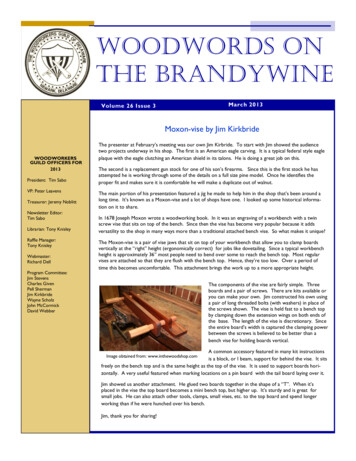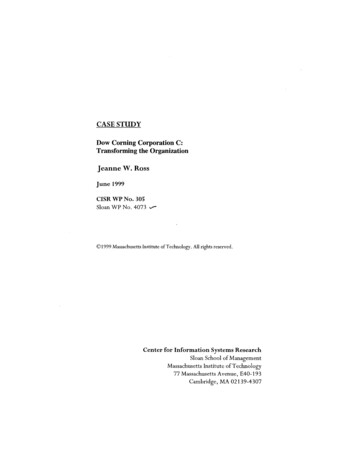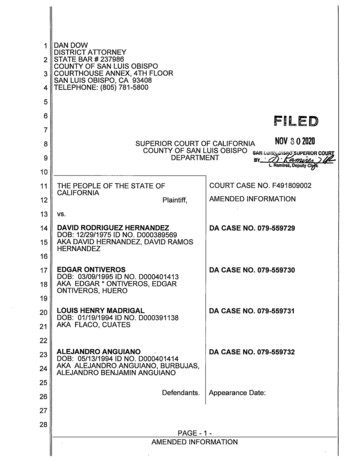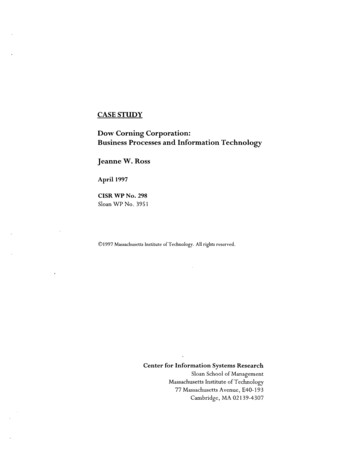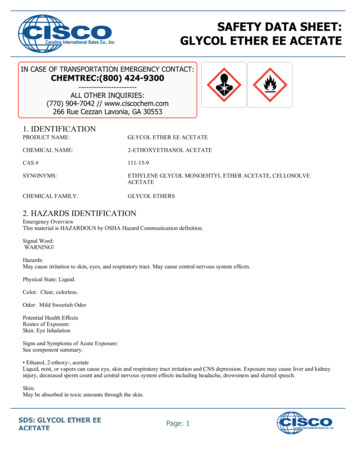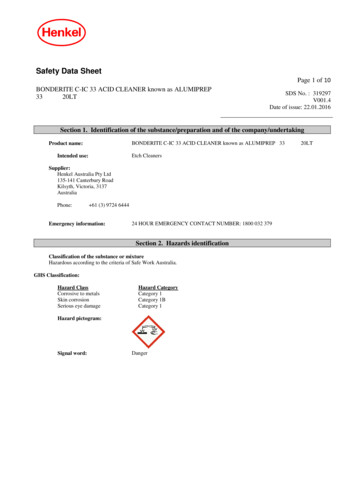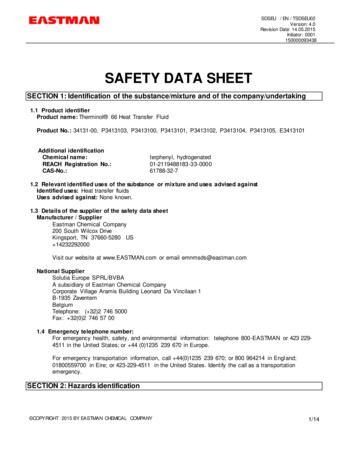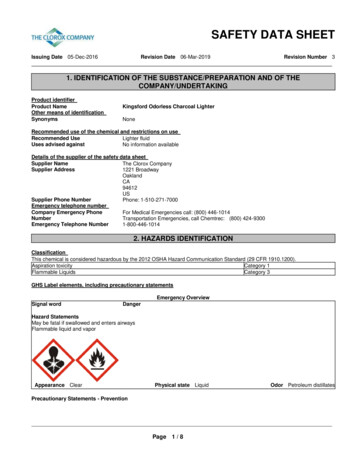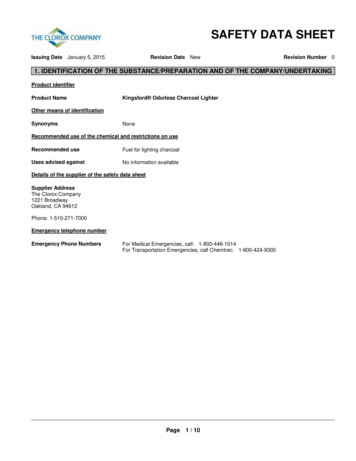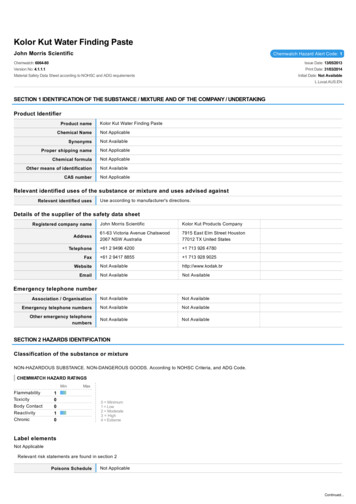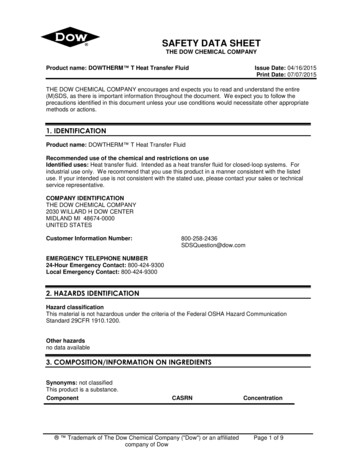
Transcription
SAFETY DATA SHEETTHE DOW CHEMICAL COMPANYProduct name: DOWTHERM T Heat Transfer FluidIssue Date: 04/16/2015Print Date: 07/07/2015THE DOW CHEMICAL COMPANY encourages and expects you to read and understand the entire(M)SDS, as there is important information throughout the document. We expect you to follow theprecautions identified in this document unless your use conditions would necessitate other appropriatemethods or actions.1. IDENTIFICATIONProduct name: DOWTHERM T Heat Transfer FluidRecommended use of the chemical and restrictions on useIdentified uses: Heat transfer fluid. Intended as a heat transfer fluid for closed-loop systems. Forindustrial use only. We recommend that you use this product in a manner consistent with the listeduse. If your intended use is not consistent with the stated use, please contact your sales or technicalservice representative.COMPANY IDENTIFICATIONTHE DOW CHEMICAL COMPANY2030 WILLARD H DOW CENTERMIDLAND MI 48674-0000UNITED STATESCustomer Information Number:800-258-2436SDSQuestion@dow.comEMERGENCY TELEPHONE NUMBER24-Hour Emergency Contact: 800-424-9300Local Emergency Contact: 800-424-93002. HAZARDS IDENTIFICATIONHazard classificationThis material is not hazardous under the criteria of the Federal OSHA Hazard CommunicationStandard 29CFR 1910.1200.Other hazardsno data available3. COMPOSITION/INFORMATION ON INGREDIENTSSynonyms: not classifiedThis product is a substance.ComponentCASRN Trademark of The Dow Chemical Company ("Dow") or an affiliatedcompany of DowConcentrationPage 1 of 9
Product name: DOWTHERM T Heat Transfer FluidIssue Date: 04/16/2015Benzene, C14-30-alkyl derivatives100.0%68855-24-34. FIRST AID MEASURESDescription of first aid measuresGeneral advice: First Aid responders should pay attention to self-protection and use therecommended protective clothing (chemical resistant gloves, splash protection). If potential forexposure exists refer to Section 8 for specific personal protective equipment.Inhalation: Move person to fresh air. If not breathing, give artificial respiration; if by mouth to mouthuse rescuer protection (pocket mask, etc). If breathing is difficult, oxygen should be administered byqualified personnel. Call a physician or transport to a medical facility.Skin contact: Wash off with plenty of water.Eye contact: Flush eyes thoroughly with water for several minutes. Remove contact lenses after theinitial 1-2 minutes and continue flushing for several additional minutes. If effects occur, consult aphysician, preferably an ophthalmologist.Ingestion: No emergency medical treatment necessary.Most important symptoms and effects, both acute and delayed: Aside from the information foundunder Description of first aid measures (above) and Indication of immediate medical attention andspecial treatment needed (below), any additional important symptoms and effects are described inSection 11: Toxicology Information.Indication of any immediate medical attention and special treatment neededNotes to physician: Maintain adequate ventilation and oxygenation of the patient. No specificantidote. Treatment of exposure should be directed at the control of symptoms and the clinicalcondition of the patient.5. FIREFIGHTING MEASURESSuitable extinguishing media: Water fog or fine spray. Dry chemical fire extinguishers. Carbondioxide fire extinguishers. Foam. Alcohol resistant foams (ATC type) are preferred. General purposesynthetic foams (including AFFF) or protein foams may function, but will be less effective.Unsuitable extinguishing media: Do not use direct water stream. May spread fire.Special hazards arising from the substance or mixtureHazardous combustion products: During a fire, smoke may contain the original material in additionto combustion products of varying composition which may be toxic and/or irritating. Combustionproducts may include and are not limited to: Hydrocarbons. Carbon monoxide. Carbon dioxide.Unusual Fire and Explosion Hazards: Violent steam generation or eruption may occur uponapplication of direct water stream to hot liquids. Liquid mist of this product can burn. Flammableconcentrations of vapor can accumulate at temperatures above flash point; see Section 9.Advice for firefightersPage 2 of 9
Product name: DOWTHERM T Heat Transfer FluidIssue Date: 04/16/2015Fire Fighting Procedures: Keep people away. Isolate fire and deny unnecessary entry. Do not usedirect water stream. May spread fire. Burning liquids may be moved by flushing with water to protectpersonnel and minimize property damage. Avoid accumulation of water. Product may be carriedacross water surface spreading fire or contracting an ignition source. Contain fire water run-off ifpossible. Fire water run-off, if not contained, may cause environmental damage. Review the"Accidental Release Measures" and the "Ecological Information" sections of this (M)SDS.Special protective equipment for firefighters: Wear positive-pressure self-contained breathingapparatus (SCBA) and protective fire fighting clothing (includes fire fighting helmet, coat, trousers,boots, and gloves). If protective equipment is not available or not used, fight fire from a protectedlocation or safe distance.6. ACCIDENTAL RELEASE MEASURESPersonal precautions, protective equipment and emergency procedures: Isolate area. Keepupwind of spill. Ventilate area of leak or spill. Keep unnecessary and unprotected personnel fromentering the area. Refer to section 7, Handling, for additional precautionary measures. Useappropriate safety equipment. For additional information, refer to Section 8, Exposure Controls andPersonal Protection.Environmental precautions: Prevent from entering into soil, ditches, sewers, waterways and/orgroundwater. See Section 12, Ecological Information.Methods and materials for containment and cleaning up: Small spills: Absorb with materials suchas: Non-combustible material. Collect in suitable and properly labeled containers. Large spills: Dikearea to contain spill. Pump into suitable and properly labeled containers. See Section 13, DisposalConsiderations, for additional information.7. HANDLING AND STORAGEPrecautions for safe handling: Avoid contact with eyes, skin, and clothing. Avoid breathing vapor.Wash thoroughly after handling. Keep container closed. Use with adequate ventilation. See Section8, EXPOSURE CONTROLS AND PERSONAL PROTECTION.Spills of these organic materials on hot fibrous insulations may lead to lowering of the autoignitiontemperatures possibly resulting in spontaneous combustion.Conditions for safe storage: Do not store in: Opened or unlabeled containers. Store away fromincompatible materials. See STABILITY AND REACTIVITY section. Avoid contact with air (oxygen).Store in tightly closed container. See Section 10 for more specific information. Additional storage andhandling information on this product may be obtained by calling your sales or customer servicecontact.8. EXPOSURE CONTROLS/PERSONAL PROTECTIONControl parametersExposure limits are listed below, if they exist.None establishedPage 3 of 9
Product name: DOWTHERM T Heat Transfer FluidIssue Date: 04/16/2015Exposure controlsEngineering controls: Use local exhaust ventilation, or other engineering controls to maintainairborne levels below exposure limit requirements or guidelines. If there are no applicable exposurelimit requirements or guidelines, general ventilation should be sufficient for most operations. Localexhaust ventilation may be necessary for some operations.Individual protection measuresEye/face protection: Use chemical goggles.Skin protectionHand protection: Use gloves chemically resistant to this material when prolonged orfrequently repeated contact could occur. Examples of preferred glove barriermaterials include: Polyethylene. Ethyl vinyl alcohol laminate ("EVAL"). Polyvinylalcohol ("PVA"). Polyvinyl chloride ("PVC" or "vinyl"). Styrene/butadiene rubber.Viton. Examples of acceptable glove barrier materials include: Butyl rubber.Chlorinated polyethylene. Natural rubber ("latex"). Neoprene. Nitrile/butadienerubber ("nitrile" or "NBR"). NOTICE: The selection of a specific glove for a particularapplication and duration of use in a workplace should also take into account allrelevant workplace factors such as, but not limited to: Other chemicals which may behandled, physical requirements (cut/puncture protection, dexterity, thermal protection),potential body reactions to glove materials, as well as the instructions/specificationsprovided by the glove supplier.Other protection: Wear clean, body-covering clothing.Respiratory protection: Respiratory protection should be worn when there is a potential toexceed the exposure limit requirements or guidelines. If there are no applicable exposure limitrequirements or guidelines, wear respiratory protection when adverse effects, such asrespiratory irritation or discomfort have been experienced, or where indicated by your riskassessment process. For emergency conditions, use an approved positive-pressure selfcontained breathing apparatus.The following should be effective types of air-purifying respirators: Organic vapor cartridge.9. PHYSICAL AND CHEMICAL PROPERTIESAppearancePhysical stateColorOdorOdor ThresholdpHMelting point/rangeFreezing pointBoiling point (760 mmHg)Flash pointEvaporation Rate (Butyl Acetate 1)Flammability (solid, gas)Lower explosion limitUpper explosion limitVapor PressureRelative Vapor Density (air 1)Liquid.YellowOdorlessOdorlessNot applicableNot applicable to liquids -40 C ( -40 F) Literature pour point 320 C ( 608 F) ASTM D86 (@ 1 atmosphere)closed cup 170 C ( 338 F) ASTM D 93 0.1 Estimated.Not applicable to liquidsNot determinedNot determined 0.01 mmHg at 20 C (68 F) MeasuredNot determinedPage 4 of 9
Product name: DOWTHERM T Heat Transfer FluidRelative Density (water 1)Water solubilityPartition coefficient: noctanol/waterAuto-ignition temperatureDecomposition temperatureKinematic ViscosityExplosive propertiesOxidizing propertiesMolecular weightIssue Date: 04/16/20150.86 - 0.89 at 15 C (59 F) Literature0.0001 % Literatureno data available375 C (707 F) ASTM D2155No test data available12 - 27 mm2/s at 40 C (104 F) ASTM D7042no data availableno data available318 g/mol LiteratureNOTE: The physical data presented above are typical values and should not be construed as aspecification.10. STABILITY AND REACTIVITYReactivity: no data availableChemical stability: Thermally stable at typical use temperatures.Possibility of hazardous reactions: Polymerization will not occur.Conditions to avoid: Avoid temperatures above 310 CAvoid contact with air (oxygen). Exposure to elevated temperatures can cause product to decompose.Incompatible materials: Avoid contact with oxidizing materials.Hazardous decomposition products: Decomposition products depend upon temperature, air supplyand the presence of other materials.11. TOXICOLOGICAL INFORMATIONToxicological information on this product or its components appear in this section when such data isavailable.Acute toxicityAcute oral toxicityVery low toxicity if swallowed. Harmful effects not anticipated from swallowing small amounts.LD50, Rat, 15,800 mg/kgAcute dermal toxicityProlonged skin contact is unlikely to result in absorption of harmful amounts.LD50, Rabbit, 7,940 mg/kgAcute inhalation toxicityPage 5 of 9
Product name: DOWTHERM T Heat Transfer FluidIssue Date: 04/16/2015At room temperature, exposure to vapor is minimal due to low volatility. Vapor from heatedmaterial may cause respiratory irritation and other effects. Excessive exposure to solvent(s)may cause respiratory irritation and central nervous system depression. Signs and symptomsof excessive exposure may include: Increased respiratory rate. Headache. Dizziness.Incoordination. Nausea and/or vomiting. Loss of appetite. Unconsciousness.The LC50 has not been determined.Skin corrosion/irritationProlonged contact may cause moderate skin irritation with local redness.Serious eye damage/eye irritationMay cause slight eye irritation.SensitizationFor skin sensitization:No relevant data found.For respiratory sensitization:No relevant information found.Specific Target Organ Systemic Toxicity (Single Exposure)Evaluation of available data suggests that this material is not an STOT-SE toxicant.Specific Target Organ Systemic Toxicity (Repeated Exposure)In animals, effects have been reported on the following organs:Central nervous system.CarcinogenicityNo relevant data found.TeratogenicityNo relevant data found.Reproductive toxicityNo relevant data found.MutagenicityNo relevant data found.Aspiration HazardBased on available information, aspiration hazard could not be determined.COMPONENTS INFLUENCING TOXICOLOGY:Benzene, C14-30-alkyl derivativesAcute inhalation toxicityThe LC50 has not been determined.12. ECOLOGICAL INFORMATIONPage 6 of 9
Product name: DOWTHERM T Heat Transfer FluidIssue Date: 04/16/2015Ecotoxicological information on this product or its components appear in this section when such datais available.ToxicityAcute toxicity to fishMaterial is practically non-toxic to aquatic organisms on an acute basis(LC50/EC50/EL50/LL50 100 mg/L in the most sensitive species tested).Acute toxicity to aquatic invertebratesEC50, Daphnia magna (Water flea), 48 Hour, 600 mg/l, Method Not Specified.Persistence and degradabilityBiodegradability: Biodegradation may occur under aerobic conditions (in the presence ofoxygen).Bioaccumulative potentialBioaccumulation: Bioconcentration potential is high (BCF 3000 or Log Pow between 5 and7).Mobility in soilNo relevant data found.13. DISPOSAL CONSIDERATIONSDisposal methods: DO NOT DUMP INTO ANY SEWERS, ON THE GROUND, OR INTO ANY BODYOF WATER. All disposal practices must be in compliance with all Federal, State/Provincial and locallaws and regulations. Regulations may vary in different locations. Waste characterizations andcompliance with applicable laws are the responsibility solely of the waste generator. AS YOURSUPPLIER,
Product name: DOWTHERM T Heat Transfer Fluid Issue Date: 04/16/2015 Page 3 of 9 Fire Fighting Procedures: Keep people away. Isolate fire and deny unnecessary entry. Do not use direct water stream. May spread fire. Burning liquids may be moved by flushing with water to protect personnel and minimize property damage. Avoid accumulation of water. Product may be carried
